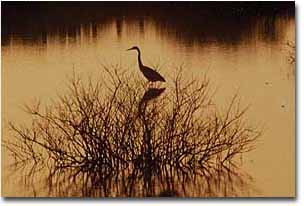 This 382-acre site situated along the Chicamuxen Creek, a Potomac River tributary, in western Charles County consists of prime marshlands as well as uplands, rolling forested habitats, and agricultural fields. The property was the site of a Civil War encampment under the leadership of Union General, Joseph Hooker.
This 382-acre site situated along the Chicamuxen Creek, a Potomac River tributary, in western Charles County consists of prime marshlands as well as uplands, rolling forested habitats, and agricultural fields. The property was the site of a Civil War encampment under the leadership of Union General, Joseph Hooker.
What to see
Chicamuxen marshes abound with a wide variety of waterfowl species including Black Ducks, Gadwall, Mallards, Widgeon, Wood Duck, Bufflehead, Hooded Merganser, Ring-neck, and occasional Scaup and Canvasback. Adult and immature bald eagles can be seen almost daily hunting the marshes and upland areas. A wide variety of forest interior dwelling birds can be observed during the nesting season. Upland areas featuring wildflowers and native grasses, early successional fields and annual wildlife plantings attract a myriad of species to the upland openings.
What to do
Hunters enjoy the pursuit of the numerous white-tailed deer found on the property, as well as the abundant puddle ducks which can be hunted at waterfowl blinds along Chicamuxen Creek. Check out a map of the area. Birders and hiders enjoy traversing the many trails which wind throughout the property.
Area Regulations
- Click here to apply for the free Southern Region Public Hunting Permit.
- Use of Chicamuxen WMA is generally permitted seven days a week.
- Hunting is allowed in accordance with open seasons, bag limits and shooting hours.
- Trapping and waterfowl hunting is by permit only.
- Motorized vehicles are prohibited.
Non-hunting Users
- Non-hunting visitors are welcome.
- Be aware of open hunting seasons and visit accordingly.
- Birders and hikers enjoy traversing the many trails that wind throughout the property; however, the trails are not marked and are only minimally maintained.
- The marshes are rich with bald eagles, osprey, hawks, turtles, and herons.
- A wide variety of forest interior dwelling birds can be observed in the upland forests during the nesting season.
- The upland areas are lush with wildflowers, native grasses, early succession fields and annual wildlife plantings that attract and support a myriad of wildlife.
Site Management Practices
- Herbaceous cover and food plots are planted and maintained.
- Numerous wood duck and blue bird boxes have been erected and are maintained.
- The marsh and upland areas are burned in rotation to control invasive species, promote native vegetation, and improve foraging habitat.
 Directions
Directions
Chicamuxen WMA is located in Charles County 8 miles south of Mason Springs on Rt. 224. Take Rt. 210 south to Indian Head. Travel east on Rt. 225 for 2 miles, then Rt. 224 south to Chicamuxen WMA. For additional information, contact the Myrtle Grove Work Center at (301) 743-5161.
 Click Here for Map
Click Here for Map
Photograph by: Chuck Prahl
This area is a part of Maryland’s Department of Natural Resources public land system and is managed by the Wildlife and Heritage Service. The primary mission of the WMA system is to conserve and enhance wildlife populations and their respective habitats as well as to provide public recreational use of the State’s wildlife resources.
Eighty-five percent of the funding for Maryland's state wildlife programs comes from hunting license fees and a federal excise tax on sport hunting devices and ammunition. The federal aid funds are derived from the Federal Aid in Wildlife Restoration (or Pittman-Robertson) Fund, which sportsmen and women have been contributing to since 1937. Each state receives a share of the funds, which is administered by the U. S. Fish and Wildlife Service; these funds are used for wildlife conservation and hunter education programs, including the management of the WMA system.
Other sources of funds for land acquisition include Program Open Space Funding for Maryland's State and local parks and conservation areas, provided through The Department of Natural Resources' Program Open Space. Established in 1969, Program Open Space symbolizes Maryland's long-term commitment to conserving natural resources while providing exceptional outdoor recreation opportunities.